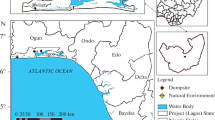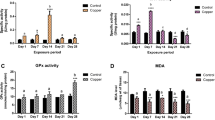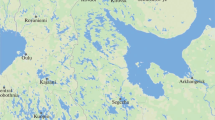Abstract
This study makes a multifactor analysis of the joint effect of reservoir contamination, parasitic infestation, and experimental hyperthermia on the activity of antioxidative enzymes (peroxidase, catalase, and glutathione S-transferase) in the pulmonate mollusk Lymnaea stagnalis from the clean Naroch Lake and contaminated Chizhovsky Reservoir in the Republic of Belarus. The activity of peroxidase is ascertained to be affected most strongly by the simultaneous effect of parasitic infestation and reservoir contamination and parasitic infestation coupled with experimental hyperthermia. The joint effect of parasitic infestation and reservoir pollution is found to influence the activity of catalase. Meanwhile, no correlation is found between the studied factors and the activity of glutathione S-transferase. It is shown that there is no mutual influence of the three studied factors on the activity of the investigated enzymes.
Similar content being viewed by others
References
Abele, D., Tesch, C., Wencke, P., et al., How does oxidative stress relate to thermal tolerance in the Antarctic bivalve Yoldia eightsi? Antarct. Sci., 2001, vol. 13, no. 2, pp. 111–118.
Adema, C.M., Sapp, K.K., Hertel, L.A., and Loker, E.S., Immunobiology of the relationships of the echinostomes with snail intermediate hosts, in Echinostomes as Experimental Models for Biological Research, Dordrecht: Kluwer, 2000, pp. 149–173.
Aebi, H., Catalase in vitro, Methods Enzymol., 1984, vol. 105, pp. 121–126.
Ataev, G.L. and Coustau, C., Cellular response to Echinostoma caproni infection in Biomphalaria glabrata strains selected for susceptibility resistance, Dev. Comp. Immunol., 1999, vol. 23, pp. 187–198.
Ataev, G.L. and Molevshchikov, A.V., Protective reactions of gastropod molluscs. 1. Cell reactions, Parazitologiya, 2004, no. 4, pp. 342–351.
Axenov-Gribanov, D.V., Vereshchagina, K.P., Lubyaga, Yu.A., Gurkov, A.N., Bedulina, D.S., Shatilina, Zh.M., Khomich, A.S., Golubev, A.P., and Timofeyev, M.A., Stress response at the cellular and biochemical levels indicates the limitation of the environmental temperature range for Eastern Siberia populations of the common gastropod Lymnaea stagnalis, Malacologia, 2015, vol. 59, no. 1, pp. 33–34.
Bechtold, D.A., Rush, S.J., and Brown, I.R., Localization of the heat-sock protein HSP70 to the synapse following hypertermic stress in the brain, J. Neurochem., 2000, vol. 74, pp. 641–646.
Bondarevich, N.V., Kozlovskii, I.S., and Novik, G.I., microbiological plankton of the Svisloch’ River with the channel in Minsk, Mater. 7oi Vseross. nauchnoprakt. konf. s mezhdunar. uchastiem “Ekologicheskie problemy promyshlennykh gorodov,” Saratov, 8–10 aprelya 2015 g., Tezisy dokladov (Proc. 7th All-Russ. Sci.- Pract. Conf. with Int. Participation “Ecological Problems of Industrial Cities,” Saratov, April 8–10, 2015, Abstracts of Papers), Saratov, 2015, pp. 24–26.
Borovikov, V.P., Iskusstvo analiza dannykh na komp’yutere (The Art of Computer Data Analysis), St. Petersburg: Statistica. 2003.
Bradford, M.M., A rapid and sensitive method for the quantitation of microgram quantities of protein utilizing the principle of protein-dye binding, Anal. Biochem., 1976, vol. 72, nos. 1–2, pp. 248–254.
Camargo, J.A. and Alonso, Á., Ecological and toxicological effects of inorganic nitrogen pollution in aquatic ecosystems: a global assessment, Environ. Int., 2006, vol. 32, no. 6, pp. 831–849.
Chapple, J.P., Smerdon, G.R., and Hawkirs, A.J.S., Stress-70 protein induction in Mitilis edulis: tissuespecific responses to elevated temperature reflect relative vulnerability and physiological function, J. Exp. Mar. Biol. Ecol., 1997, vol. 217, pp. 225–235.
Chuiko, G.M., Tillitt, D.E., and Zajicek, J.L., Chemical contamination of the Rybinsk reservoir, northwest Russia: relationship between liver polychlorinated biphenyls (PCB) content and health indicators in bream (Abramis brama), Chemosphere, 2007, vol. 67, no. 3, pp. 527–536.
Connors, V.A., Lodes, M.J., and Yoshin, T.P., Identification of Schistosoma mansoni sporocyst excretory secretory antioxidant molecule and its effect on superoxide production by Biomphalaria glabrata hemocytes, J. Invertebr. Pathol., 1991, vol. 58, pp. 387–395
Dorozhenkova, T.E. and Bekish, O.Ya.L., Sposob opredeleniya vidovoi prinadlezhnosti tserkariev ptich’ikh trematod semeistva Schistosomatidae v bryukhonogikh legochnykh mollyuskakh. Instruktsiya po primeneniyu (Determination of Species Affiliation of Cercariae of the Bird Trematodes of Family Schistosomatidae in Pulmonary Gastropods: Instruction for Implementation), Minsk: Minist. Zdravookhr. Resp. Belarus, 2007.
Drotar, A., Phelps, P., and Fall, R., Evidence for glutathione peroxidase activities in cultured plant cells., Plant Sci., 1985, vol. 42, pp. 35–40.
Habig, W.H., Pabst, M.J., and Jakoby, W.B., Glutathione S-transferases: the first enzymatic step in mercapturic acid formation, J. Biol. Chem., 1974, vol. 249, pp. 7130–7139.
Gladyshev, M.B., Gribovskaya, I.V., and Ivanova, E.A., Metal concentrations in the ecosystem and around recreational and fish-breeding pond Bugach, Water Resour., 2001, vol. 28, no. 3, pp. 288–296.
Gnatishina, L.L., Fal’fushinskaya, G.I., Golubev, A.P., Dallinger, R., and Stoliar, O.B., Role of metallothioneins in adaptation of Lymnaea stagnalis (Mollusca: Pulmonata) to environment pollution, Hydrobiol. J., 2011, vol. 47, no. 5, pp. 56–66.
Golubev, A.P., Thermoresistance and radioresistance of the population of Lymnaea stagnalis (Gastropoda, Pulmonata) from water bodies with different types of anthropogenic pressure, Dokl. Biol. Sci., 1995, vol. 342, no. 2, pp. 280–283.
Golubev, A.P., Samooplodotvorenie u presnovodnykh legochnykh mollyuskov. Kolichetvennaya otsenka i adaptivnoe znachenie (Autogamy of Freshwater Pulmonata Mollusks: Quantitative Evaluation and Adaptive Value), Minsk: Pravo i Ekonomika, 2014.
Golubev, A., Afonin, V., Maksimova, S., and Androsov, V., The current state of pond snail Lymnaea stagnalis (Gastropoda, Pulmonata) populations from water reservoirs of the Chernobyl nuclear accident zone, Radioprotection, 2005, vol. 40, no. 1, pp. 511–517.
Grosell, M., Gerdes, R.M., and Brix, K.V., Chronic toxicity of lead to three freshwater invertebrates—Brachionus calyciflorus, Chironomus tentans, and Lymnaea stagnalis, Environ. Toxicol. Chem., 2006, vol. 25, no. 1, pp. 97–104.
Haas, W., Parasitic worms: strategies of host finding, recognition and invasion, Zoology, 2003, vol. 106, pp. 349–364.
Hellou, J. and Law, R.J., Stress on stress response of wild mussels, Mytilus edulis and Mytilus trossulus, as an indicator of ecosystem health, Environ. Pollut., 2003, vol. 126, no. 3, pp. 407–416.
Hochachka, P.W. and Somero, G.N., Biochemical Adaptation: Mechanism and Process in Physiological Evolution, New York: Oxford Univ. Press, 2016.
Kamlyuk, L.V., Semenyuk, G.A., and Eremova, N.G., Dominant complex and seasonal dynamics of development of zooplankton in urban reservoirs, Vestn. Belarus. Gos. Univ., 2002, pp. 40–45.
Kryukova, N.A., Yurlova, N.I., Rastyagenko, N.M., Antonova, E.V., and Glupov, V.V., The influence of Plagiorchis mutationis larval infection on the cellular immune response of the snail host Lymnaea stagnalis, J. Parasitol., 2014, vol. 100, no. 3, pp. 284–287.
Lushchak, V.I., Environmentally induced oxidative stress in aquatic animals, Aquat. Toxicol., 2011, no. 10, pp. 13–30.
Lushchak, V.I., Bagnyukova, T.V., Husak, V.V., et al., Hyperoxia results in transient oxidative stress and an adaptive response by antioxidant enzymes in goldfish tissues, Int. J. Biochem. Cell Biol., 2005, vol. 37, pp. 1670–1680.
Ostapenya, A.P., Zhukova, T.V., Mikheeva, T.M., Kovalevskaya, R.Z., Makarevich, T.A., Zhukova, A.A., Luk’yanova, E.V., Nikitina, L.V., Makarevich, O.A., Dubko, N.V., Karabanovich, V.S., Savich, I.V., and Veres, Yu.K., Benthification of the lake ecosystems: reasons, mechanisms, possible consequences, and prospective studies, Tr. Belarus. Gos. Univ., 2012, no. 7, pp. 135–148.
Sidorov, A.V., Influence of temperature on respiration, defensive behavior, and locomotion of freshwater snail Lymnaea stagnalis, Zh. Vyssh. Nervn. Deyat. im. I.P. Pavlova, 2003, no. 4, pp. 513–517.
Soldánová, M., Selbach, C., Sures, B., Kostadinova, A., and Pérez-del-Olmo, A., Larval trematode communities in Radix auricularia and Lymnaea stagnalis in a reservoir system of the Ruhr River, Parasites Vectors, 2010, vol. 3, no. 1, p.56.
Spees, J.L., Chang, S.A., Mykles, D.L., et al., Molt cycledependent molecular chaperone and polyubiquitin gene expression in lobster, Cell Stress Chaperones, 2003, vol. 8, no. 3, pp. 258–264.
Teskey, M.L., Lukowiak, K.S., Riaz, H., Dalesman, S., and Lukowiak, K., What’s hot: the enhancing effects of thermal stress on long-term memory formation in Lymnaea stagnalis, J. Exp. Biol., 2012, vol. 215, no. 24, pp. 4322–4329.
Troschinski, S., Di Lellis, M.A., Sereda, S., Hauffe, T., Wilke, T., Triebskorn, R., and Kohler, H.R., Intraspecific variation in cellular and biochemical heat response strategies of Mediterranean Xeropicta derbentina (Pulmonata, Hygromiidae), PLoS One, 2014, vol. 9, no. 1, p. e86613.
Tunholi-Alves, V.M., Tunholi, V.M., Castro, R.N., Sant’Ana, L.D.O., Santos-Amaral, L., de Oliveira, A.P.M., and Maldonado, A., Activation of anaerobic metabolism in Biomphalaria glabrata (Mollusca: Gastropoda) experimentally infected by Angiostrongylus cantonensis (Nematoda, Metastrongylidae) by high-performance liquid chromatography, Parasitol. Int., 2014, vol. 63, no. 1, pp. 64–68.
Van der Schalie, H. and Berry, E.G., Effects of Temperature on Growth and Reproduction of Aquatic Snails, Washington: US Environ. Protect. Agency, 1973.
Author information
Authors and Affiliations
Corresponding author
Additional information
Original Russian Text © A.S. Khomich, D.V. Axenov-Gribanov, O.A. Bodilovskaya, Y.A. Shirokova, E.P. Shchapova, Y.A. Lubyaga, Z.M. Shatilina, V.A. Emshanova, A.P. Golubev, 2017, published in Sibirskii Ekologicheskii Zhurnal, 2017, No. 2, pp. 184–192.
Rights and permissions
About this article
Cite this article
Khomich, A.S., Axenov-Gribanov, D.V., Bodilovskaya, O.A. et al. Assessment of the joint effect of thermal stress, pollution, and parasitic infestation on the activity of antioxidative enzymes in pulmonate mollusk Lymnaea stagnalis . Contemp. Probl. Ecol. 10, 157–163 (2017). https://doi.org/10.1134/S1995425517020068
Received:
Accepted:
Published:
Issue Date:
DOI: https://doi.org/10.1134/S1995425517020068




